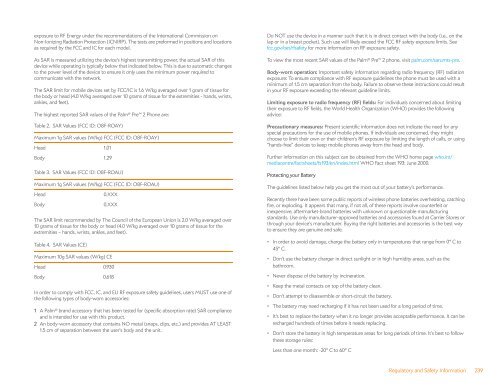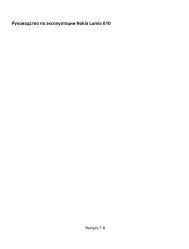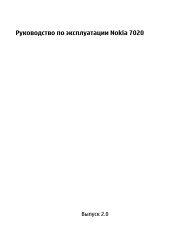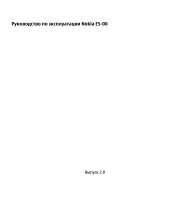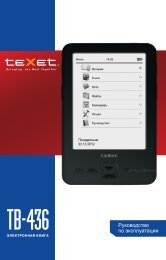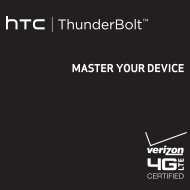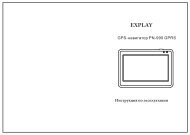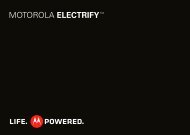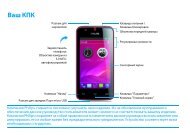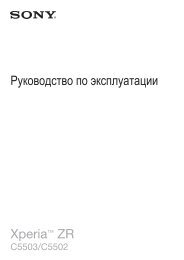Palm Pre 2 User Guide (World Ready) - DevDB
Palm Pre 2 User Guide (World Ready) - DevDB
Palm Pre 2 User Guide (World Ready) - DevDB
Create successful ePaper yourself
Turn your PDF publications into a flip-book with our unique Google optimized e-Paper software.
exposure to RF Energy under the recommendations of the International Commission on<br />
Non-Ionizing Radiation Protection (ICNIRP). The tests are preformed in positions and locations<br />
as required by the FCC and IC for each model.<br />
As SAR is measured utilizing the device's highest transmitting power, the actual SAR of this<br />
device while operating is typically below that indicated below. This is due to automatic changes<br />
to the power level of the device to ensure it only uses the minimum power required to<br />
communicate with the network.<br />
The SAR limit for mobile devices set by FCC/IC is 1.6 W/kg averaged over 1 gram of tissue for<br />
the body or head (4.0 W/kg averaged over 10 grams of tissue for the extremities - hands, wrists,<br />
ankles, and feet).<br />
The highest reported SAR values of the <strong>Palm</strong> ® <strong>Pre</strong> 2 Phone are:<br />
Table 2. SAR Values (FCC ID: O8F-ROAY)<br />
Maximum 1g SAR values (W/kg) FCC (FCC ID: O8F-ROAY)<br />
Head 1.01<br />
Body 1.29<br />
Table 3. SAR Values (FCC ID: O8F-ROAU)<br />
Maximum 1g SAR values (W/kg) FCC (FCC ID: O8F-ROAU)<br />
Head 0.XXX<br />
Body 0.XXX<br />
The SAR limit recommended by The Council of the European Union is 2.0 W/kg averaged over<br />
10 grams of tissue for the body or head (4.0 W/kg averaged over 10 grams of tissue for the<br />
extremities – hands, wrists, ankles, and feet).<br />
Table 4. SAR Values (CE)<br />
Maximum 10g SAR values (W/kg) CE<br />
Head 0.930<br />
Body 0.618<br />
In order to comply with FCC, IC, and EU RF exposure safety guidelines, users MUST use one of<br />
the following types of body-worn accessories:<br />
1 A <strong>Palm</strong> ® brand accessory that has been tested for (specific absorption rate) SAR compliance<br />
and is intended for use with this product.<br />
2 An body-worn accessory that contains NO metal (snaps, clips, etc.) and provides AT LEAST<br />
1.5 cm of separation between the user's body and the unit.<br />
Do NOT use the device in a manner such that it is in direct contact with the body (i.e., on the<br />
lap or in a breast pocket). Such use will likely exceed the FCC RF safety exposure limits. See<br />
fcc.gov/oet/rfsafety for more information on RF exposure safety.<br />
To view the most recent SAR values of the <strong>Palm</strong> ® <strong>Pre</strong> 2 phone, visit palm.com/sarumts-pre.<br />
Body-worn operation: Important safety information regarding radio frequency (RF) radiation<br />
exposure: To ensure compliance with RF exposure guidelines the phone must be used with a<br />
minimum of 1.5 cm separation from the body. Failure to observe these instructions could result<br />
in your RF exposure exceeding the relevant guideline limits.<br />
Limiting exposure to radio frequency (RF) fields: For individuals concerned about limiting<br />
their exposure to RF fields, the <strong>World</strong> Health Organization (WHO) provides the following<br />
advice:<br />
<strong>Pre</strong>cautionary measures: <strong>Pre</strong>sent scientific information does not indicate the need for any<br />
special precautions for the use of mobile phones. If individuals are concerned, they might<br />
choose to limit their own or their children's RF exposure by limiting the length of calls, or using<br />
“hands-free” devices to keep mobile phones away from the head and body.<br />
Further information on this subject can be obtained from the WHO home page who.int/<br />
mediacentre/factsheets/fs193/en/index.html WHO Fact sheet 193: June 2000.<br />
Protecting your Battery<br />
The guidelines listed below help you get the most out of your battery's performance.<br />
Recently there have been some public reports of wireless phone batteries overheating, catching<br />
fire, or exploding. It appears that many, if not all, of these reports involve counterfeit or<br />
inexpensive, aftermarket-brand batteries with unknown or questionable manufacturing<br />
standards. Use only manufacturer-approved batteries and accessories found at Carrier Stores or<br />
through your device's manufacturer. Buying the right batteries and accessories is the best way<br />
to ensure they are genuine and safe.<br />
• In order to avoid damage, charge the battery only in temperatures that range from 0° C to<br />
45° C.<br />
• Don't use the battery charger in direct sunlight or in high humidity areas, such as the<br />
bathroom.<br />
• Never dispose of the battery by incineration.<br />
• Keep the metal contacts on top of the battery clean.<br />
• Don't attempt to disassemble or short-circuit the battery.<br />
• The battery may need recharging if it has not been used for a long period of time.<br />
• It's best to replace the battery when it no longer provides acceptable performance. It can be<br />
recharged hundreds of times before it needs replacing.<br />
• Don't store the battery in high temperature areas for long periods of time. It's best to follow<br />
these storage rules:<br />
Less than one month: -20° C to 60° C<br />
Regulatory and Safety Information 239


